The Treaty of Waitangi: Biculturalism in Early Childhood Education
VerifiedAdded on 2023/06/12
|9
|2116
|214
Essay
AI Summary
This essay examines the Treaty of Waitangi, signed in 1840, and its profound influence on the New Zealand education system, particularly in early childhood education. The treaty, designed to establish principles for a bicultural constitution accommodating both Māori and non-Māori, emphasizes partnership, equity, and protection of Māori interests. The essay discusses key promises of the treaty, including addressing historical injustices and fostering a bicultural environment. It highlights how the Education Acts acknowledge the treaty by consulting with communities, promoting bilingual teaching, and funding Māori-speaking environments. Strategies for developing skills and knowledge, such as Durie Mason's integrated approach and the use of Māori concepts like "Ko te wa whakapi" and "Manaakitanga," are explored. The essay also addresses criticisms of the bicultural approach, noting challenges in implementation and resource availability, before concluding that the Treaty of Waitangi remains a vital framework for promoting biculturalism and equality in early childhood learning, encouraging cultural sustainability and individual wellbeing. Desklib offers a platform to explore similar educational resources and solved assignments.
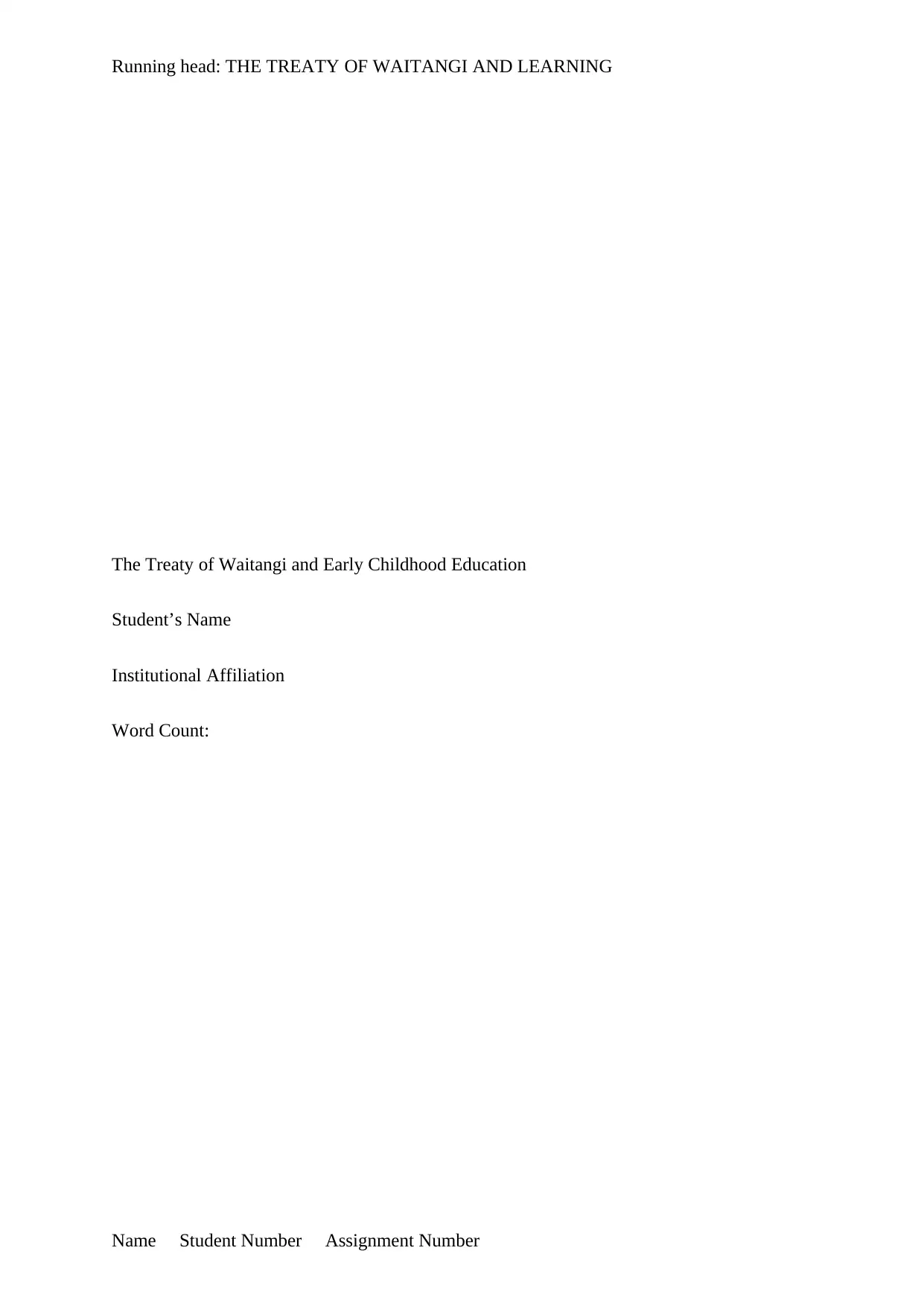
Running head: THE TREATY OF WAITANGI AND LEARNING
The Treaty of Waitangi and Early Childhood Education
Student’s Name
Institutional Affiliation
Word Count:
Name Student Number Assignment Number
The Treaty of Waitangi and Early Childhood Education
Student’s Name
Institutional Affiliation
Word Count:
Name Student Number Assignment Number
Paraphrase This Document
Need a fresh take? Get an instant paraphrase of this document with our AI Paraphraser
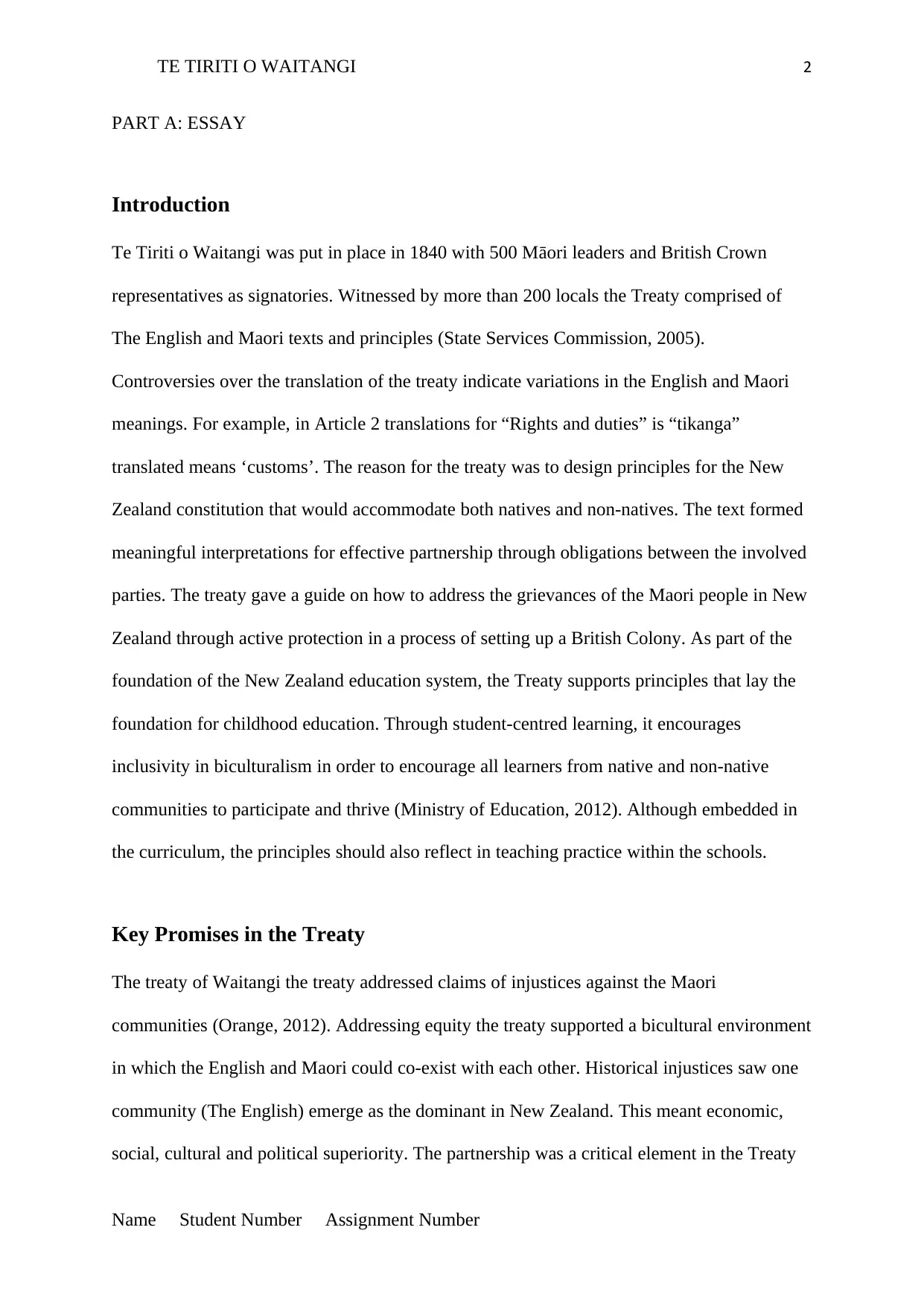
TE TIRITI O WAITANGI 2
PART A: ESSAY
Introduction
Te Tiriti o Waitangi was put in place in 1840 with 500 Māori leaders and British Crown
representatives as signatories. Witnessed by more than 200 locals the Treaty comprised of
The English and Maori texts and principles (State Services Commission, 2005).
Controversies over the translation of the treaty indicate variations in the English and Maori
meanings. For example, in Article 2 translations for “Rights and duties” is “tikanga”
translated means ‘customs’. The reason for the treaty was to design principles for the New
Zealand constitution that would accommodate both natives and non-natives. The text formed
meaningful interpretations for effective partnership through obligations between the involved
parties. The treaty gave a guide on how to address the grievances of the Maori people in New
Zealand through active protection in a process of setting up a British Colony. As part of the
foundation of the New Zealand education system, the Treaty supports principles that lay the
foundation for childhood education. Through student-centred learning, it encourages
inclusivity in biculturalism in order to encourage all learners from native and non-native
communities to participate and thrive (Ministry of Education, 2012). Although embedded in
the curriculum, the principles should also reflect in teaching practice within the schools.
Key Promises in the Treaty
The treaty of Waitangi the treaty addressed claims of injustices against the Maori
communities (Orange, 2012). Addressing equity the treaty supported a bicultural environment
in which the English and Maori could co-exist with each other. Historical injustices saw one
community (The English) emerge as the dominant in New Zealand. This meant economic,
social, cultural and political superiority. The partnership was a critical element in the Treaty
Name Student Number Assignment Number
PART A: ESSAY
Introduction
Te Tiriti o Waitangi was put in place in 1840 with 500 Māori leaders and British Crown
representatives as signatories. Witnessed by more than 200 locals the Treaty comprised of
The English and Maori texts and principles (State Services Commission, 2005).
Controversies over the translation of the treaty indicate variations in the English and Maori
meanings. For example, in Article 2 translations for “Rights and duties” is “tikanga”
translated means ‘customs’. The reason for the treaty was to design principles for the New
Zealand constitution that would accommodate both natives and non-natives. The text formed
meaningful interpretations for effective partnership through obligations between the involved
parties. The treaty gave a guide on how to address the grievances of the Maori people in New
Zealand through active protection in a process of setting up a British Colony. As part of the
foundation of the New Zealand education system, the Treaty supports principles that lay the
foundation for childhood education. Through student-centred learning, it encourages
inclusivity in biculturalism in order to encourage all learners from native and non-native
communities to participate and thrive (Ministry of Education, 2012). Although embedded in
the curriculum, the principles should also reflect in teaching practice within the schools.
Key Promises in the Treaty
The treaty of Waitangi the treaty addressed claims of injustices against the Maori
communities (Orange, 2012). Addressing equity the treaty supported a bicultural environment
in which the English and Maori could co-exist with each other. Historical injustices saw one
community (The English) emerge as the dominant in New Zealand. This meant economic,
social, cultural and political superiority. The partnership was a critical element in the Treaty
Name Student Number Assignment Number
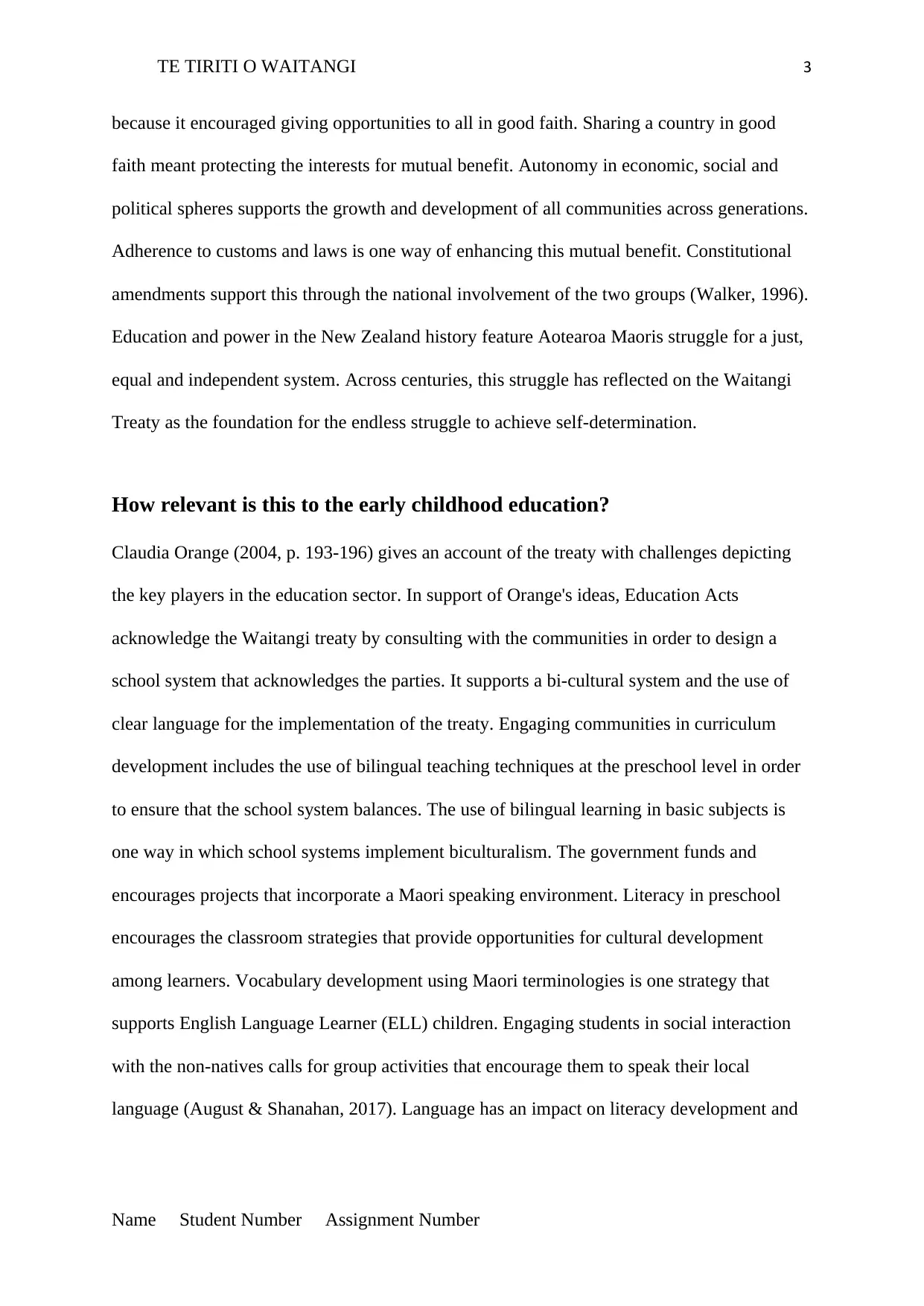
TE TIRITI O WAITANGI 3
because it encouraged giving opportunities to all in good faith. Sharing a country in good
faith meant protecting the interests for mutual benefit. Autonomy in economic, social and
political spheres supports the growth and development of all communities across generations.
Adherence to customs and laws is one way of enhancing this mutual benefit. Constitutional
amendments support this through the national involvement of the two groups (Walker, 1996).
Education and power in the New Zealand history feature Aotearoa Maoris struggle for a just,
equal and independent system. Across centuries, this struggle has reflected on the Waitangi
Treaty as the foundation for the endless struggle to achieve self-determination.
How relevant is this to the early childhood education?
Claudia Orange (2004, p. 193-196) gives an account of the treaty with challenges depicting
the key players in the education sector. In support of Orange's ideas, Education Acts
acknowledge the Waitangi treaty by consulting with the communities in order to design a
school system that acknowledges the parties. It supports a bi-cultural system and the use of
clear language for the implementation of the treaty. Engaging communities in curriculum
development includes the use of bilingual teaching techniques at the preschool level in order
to ensure that the school system balances. The use of bilingual learning in basic subjects is
one way in which school systems implement biculturalism. The government funds and
encourages projects that incorporate a Maori speaking environment. Literacy in preschool
encourages the classroom strategies that provide opportunities for cultural development
among learners. Vocabulary development using Maori terminologies is one strategy that
supports English Language Learner (ELL) children. Engaging students in social interaction
with the non-natives calls for group activities that encourage them to speak their local
language (August & Shanahan, 2017). Language has an impact on literacy development and
Name Student Number Assignment Number
because it encouraged giving opportunities to all in good faith. Sharing a country in good
faith meant protecting the interests for mutual benefit. Autonomy in economic, social and
political spheres supports the growth and development of all communities across generations.
Adherence to customs and laws is one way of enhancing this mutual benefit. Constitutional
amendments support this through the national involvement of the two groups (Walker, 1996).
Education and power in the New Zealand history feature Aotearoa Maoris struggle for a just,
equal and independent system. Across centuries, this struggle has reflected on the Waitangi
Treaty as the foundation for the endless struggle to achieve self-determination.
How relevant is this to the early childhood education?
Claudia Orange (2004, p. 193-196) gives an account of the treaty with challenges depicting
the key players in the education sector. In support of Orange's ideas, Education Acts
acknowledge the Waitangi treaty by consulting with the communities in order to design a
school system that acknowledges the parties. It supports a bi-cultural system and the use of
clear language for the implementation of the treaty. Engaging communities in curriculum
development includes the use of bilingual teaching techniques at the preschool level in order
to ensure that the school system balances. The use of bilingual learning in basic subjects is
one way in which school systems implement biculturalism. The government funds and
encourages projects that incorporate a Maori speaking environment. Literacy in preschool
encourages the classroom strategies that provide opportunities for cultural development
among learners. Vocabulary development using Maori terminologies is one strategy that
supports English Language Learner (ELL) children. Engaging students in social interaction
with the non-natives calls for group activities that encourage them to speak their local
language (August & Shanahan, 2017). Language has an impact on literacy development and
Name Student Number Assignment Number
⊘ This is a preview!⊘
Do you want full access?
Subscribe today to unlock all pages.

Trusted by 1+ million students worldwide
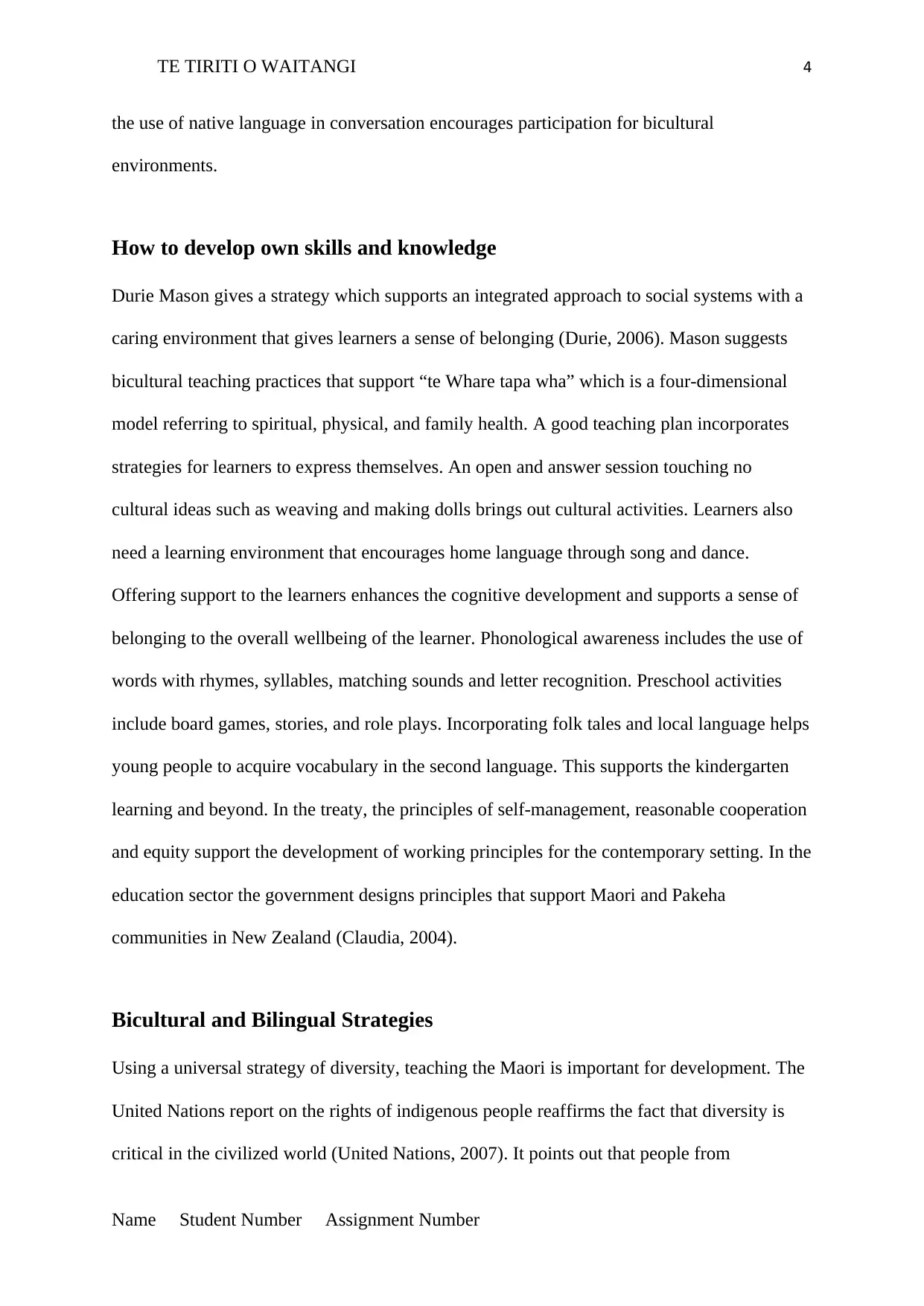
TE TIRITI O WAITANGI 4
the use of native language in conversation encourages participation for bicultural
environments.
How to develop own skills and knowledge
Durie Mason gives a strategy which supports an integrated approach to social systems with a
caring environment that gives learners a sense of belonging (Durie, 2006). Mason suggests
bicultural teaching practices that support “te Whare tapa wha” which is a four-dimensional
model referring to spiritual, physical, and family health. A good teaching plan incorporates
strategies for learners to express themselves. An open and answer session touching no
cultural ideas such as weaving and making dolls brings out cultural activities. Learners also
need a learning environment that encourages home language through song and dance.
Offering support to the learners enhances the cognitive development and supports a sense of
belonging to the overall wellbeing of the learner. Phonological awareness includes the use of
words with rhymes, syllables, matching sounds and letter recognition. Preschool activities
include board games, stories, and role plays. Incorporating folk tales and local language helps
young people to acquire vocabulary in the second language. This supports the kindergarten
learning and beyond. In the treaty, the principles of self-management, reasonable cooperation
and equity support the development of working principles for the contemporary setting. In the
education sector the government designs principles that support Maori and Pakeha
communities in New Zealand (Claudia, 2004).
Bicultural and Bilingual Strategies
Using a universal strategy of diversity, teaching the Maori is important for development. The
United Nations report on the rights of indigenous people reaffirms the fact that diversity is
critical in the civilized world (United Nations, 2007). It points out that people from
Name Student Number Assignment Number
the use of native language in conversation encourages participation for bicultural
environments.
How to develop own skills and knowledge
Durie Mason gives a strategy which supports an integrated approach to social systems with a
caring environment that gives learners a sense of belonging (Durie, 2006). Mason suggests
bicultural teaching practices that support “te Whare tapa wha” which is a four-dimensional
model referring to spiritual, physical, and family health. A good teaching plan incorporates
strategies for learners to express themselves. An open and answer session touching no
cultural ideas such as weaving and making dolls brings out cultural activities. Learners also
need a learning environment that encourages home language through song and dance.
Offering support to the learners enhances the cognitive development and supports a sense of
belonging to the overall wellbeing of the learner. Phonological awareness includes the use of
words with rhymes, syllables, matching sounds and letter recognition. Preschool activities
include board games, stories, and role plays. Incorporating folk tales and local language helps
young people to acquire vocabulary in the second language. This supports the kindergarten
learning and beyond. In the treaty, the principles of self-management, reasonable cooperation
and equity support the development of working principles for the contemporary setting. In the
education sector the government designs principles that support Maori and Pakeha
communities in New Zealand (Claudia, 2004).
Bicultural and Bilingual Strategies
Using a universal strategy of diversity, teaching the Maori is important for development. The
United Nations report on the rights of indigenous people reaffirms the fact that diversity is
critical in the civilized world (United Nations, 2007). It points out that people from
Name Student Number Assignment Number
Paraphrase This Document
Need a fresh take? Get an instant paraphrase of this document with our AI Paraphraser
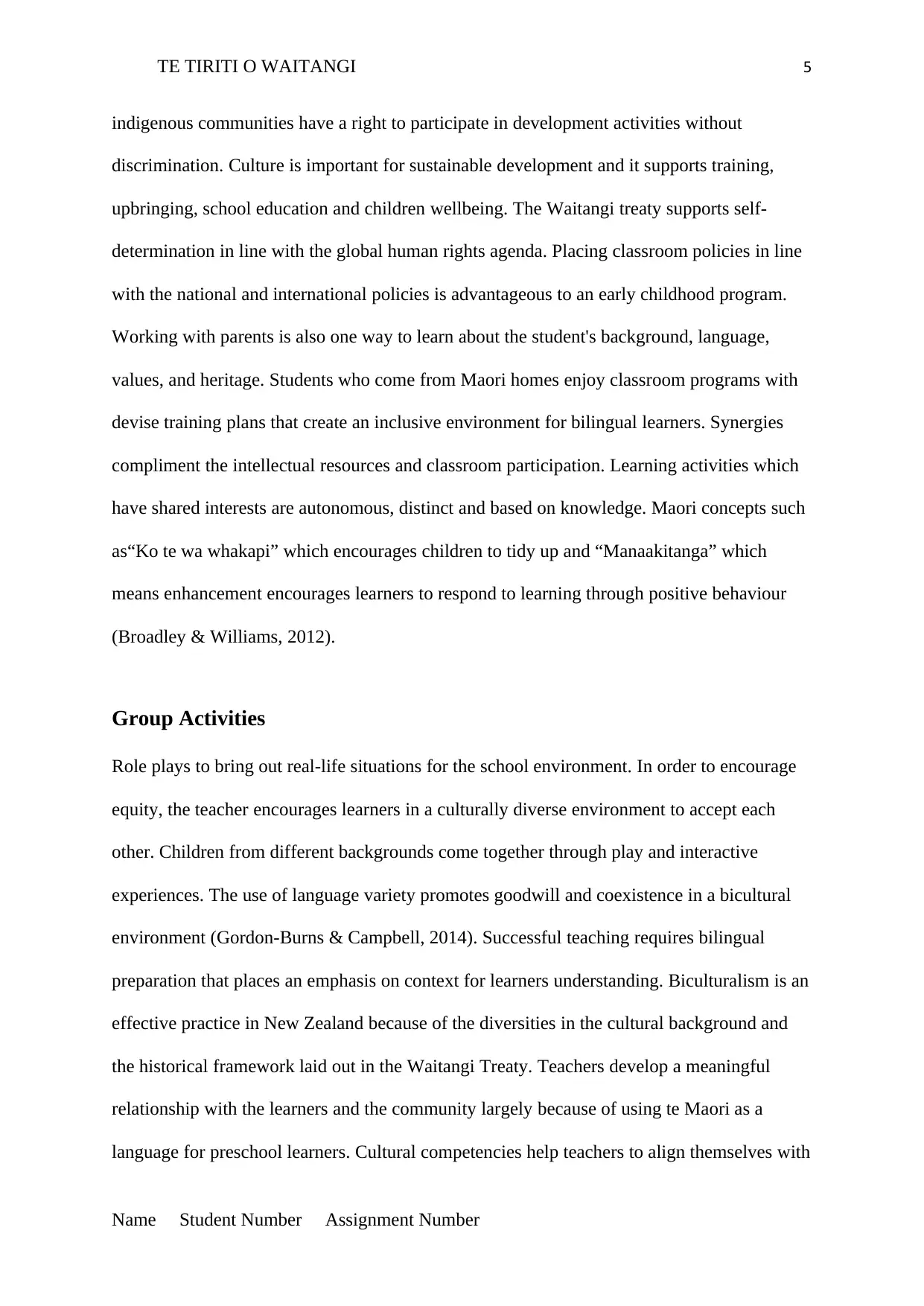
TE TIRITI O WAITANGI 5
indigenous communities have a right to participate in development activities without
discrimination. Culture is important for sustainable development and it supports training,
upbringing, school education and children wellbeing. The Waitangi treaty supports self-
determination in line with the global human rights agenda. Placing classroom policies in line
with the national and international policies is advantageous to an early childhood program.
Working with parents is also one way to learn about the student's background, language,
values, and heritage. Students who come from Maori homes enjoy classroom programs with
devise training plans that create an inclusive environment for bilingual learners. Synergies
compliment the intellectual resources and classroom participation. Learning activities which
have shared interests are autonomous, distinct and based on knowledge. Maori concepts such
as“Ko te wa whakapi” which encourages children to tidy up and “Manaakitanga” which
means enhancement encourages learners to respond to learning through positive behaviour
(Broadley & Williams, 2012).
Group Activities
Role plays to bring out real-life situations for the school environment. In order to encourage
equity, the teacher encourages learners in a culturally diverse environment to accept each
other. Children from different backgrounds come together through play and interactive
experiences. The use of language variety promotes goodwill and coexistence in a bicultural
environment (Gordon-Burns & Campbell, 2014). Successful teaching requires bilingual
preparation that places an emphasis on context for learners understanding. Biculturalism is an
effective practice in New Zealand because of the diversities in the cultural background and
the historical framework laid out in the Waitangi Treaty. Teachers develop a meaningful
relationship with the learners and the community largely because of using te Maori as a
language for preschool learners. Cultural competencies help teachers to align themselves with
Name Student Number Assignment Number
indigenous communities have a right to participate in development activities without
discrimination. Culture is important for sustainable development and it supports training,
upbringing, school education and children wellbeing. The Waitangi treaty supports self-
determination in line with the global human rights agenda. Placing classroom policies in line
with the national and international policies is advantageous to an early childhood program.
Working with parents is also one way to learn about the student's background, language,
values, and heritage. Students who come from Maori homes enjoy classroom programs with
devise training plans that create an inclusive environment for bilingual learners. Synergies
compliment the intellectual resources and classroom participation. Learning activities which
have shared interests are autonomous, distinct and based on knowledge. Maori concepts such
as“Ko te wa whakapi” which encourages children to tidy up and “Manaakitanga” which
means enhancement encourages learners to respond to learning through positive behaviour
(Broadley & Williams, 2012).
Group Activities
Role plays to bring out real-life situations for the school environment. In order to encourage
equity, the teacher encourages learners in a culturally diverse environment to accept each
other. Children from different backgrounds come together through play and interactive
experiences. The use of language variety promotes goodwill and coexistence in a bicultural
environment (Gordon-Burns & Campbell, 2014). Successful teaching requires bilingual
preparation that places an emphasis on context for learners understanding. Biculturalism is an
effective practice in New Zealand because of the diversities in the cultural background and
the historical framework laid out in the Waitangi Treaty. Teachers develop a meaningful
relationship with the learners and the community largely because of using te Maori as a
language for preschool learners. Cultural competencies help teachers to align themselves with
Name Student Number Assignment Number
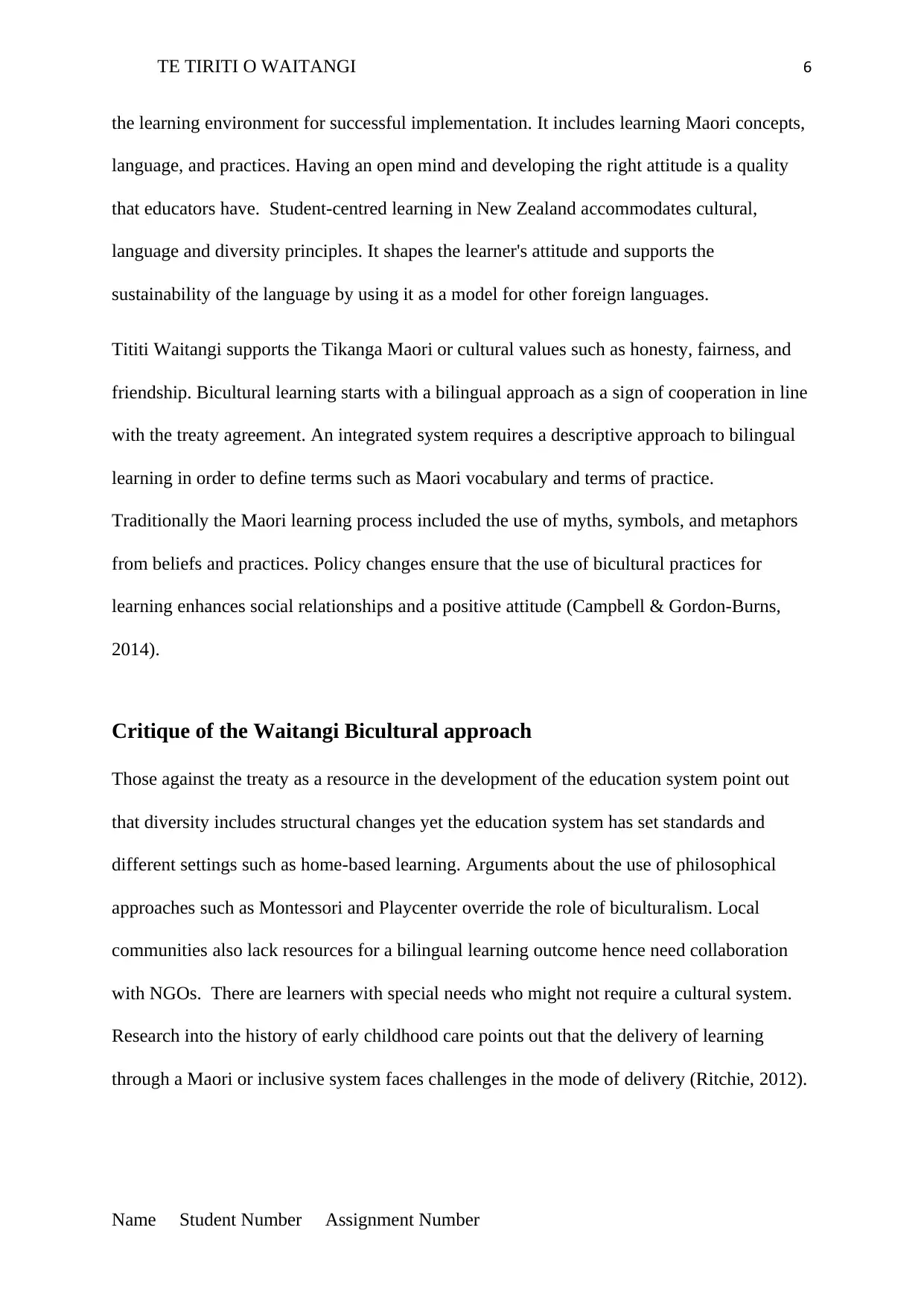
TE TIRITI O WAITANGI 6
the learning environment for successful implementation. It includes learning Maori concepts,
language, and practices. Having an open mind and developing the right attitude is a quality
that educators have. Student-centred learning in New Zealand accommodates cultural,
language and diversity principles. It shapes the learner's attitude and supports the
sustainability of the language by using it as a model for other foreign languages.
Tititi Waitangi supports the Tikanga Maori or cultural values such as honesty, fairness, and
friendship. Bicultural learning starts with a bilingual approach as a sign of cooperation in line
with the treaty agreement. An integrated system requires a descriptive approach to bilingual
learning in order to define terms such as Maori vocabulary and terms of practice.
Traditionally the Maori learning process included the use of myths, symbols, and metaphors
from beliefs and practices. Policy changes ensure that the use of bicultural practices for
learning enhances social relationships and a positive attitude (Campbell & Gordon-Burns,
2014).
Critique of the Waitangi Bicultural approach
Those against the treaty as a resource in the development of the education system point out
that diversity includes structural changes yet the education system has set standards and
different settings such as home-based learning. Arguments about the use of philosophical
approaches such as Montessori and Playcenter override the role of biculturalism. Local
communities also lack resources for a bilingual learning outcome hence need collaboration
with NGOs. There are learners with special needs who might not require a cultural system.
Research into the history of early childhood care points out that the delivery of learning
through a Maori or inclusive system faces challenges in the mode of delivery (Ritchie, 2012).
Name Student Number Assignment Number
the learning environment for successful implementation. It includes learning Maori concepts,
language, and practices. Having an open mind and developing the right attitude is a quality
that educators have. Student-centred learning in New Zealand accommodates cultural,
language and diversity principles. It shapes the learner's attitude and supports the
sustainability of the language by using it as a model for other foreign languages.
Tititi Waitangi supports the Tikanga Maori or cultural values such as honesty, fairness, and
friendship. Bicultural learning starts with a bilingual approach as a sign of cooperation in line
with the treaty agreement. An integrated system requires a descriptive approach to bilingual
learning in order to define terms such as Maori vocabulary and terms of practice.
Traditionally the Maori learning process included the use of myths, symbols, and metaphors
from beliefs and practices. Policy changes ensure that the use of bicultural practices for
learning enhances social relationships and a positive attitude (Campbell & Gordon-Burns,
2014).
Critique of the Waitangi Bicultural approach
Those against the treaty as a resource in the development of the education system point out
that diversity includes structural changes yet the education system has set standards and
different settings such as home-based learning. Arguments about the use of philosophical
approaches such as Montessori and Playcenter override the role of biculturalism. Local
communities also lack resources for a bilingual learning outcome hence need collaboration
with NGOs. There are learners with special needs who might not require a cultural system.
Research into the history of early childhood care points out that the delivery of learning
through a Maori or inclusive system faces challenges in the mode of delivery (Ritchie, 2012).
Name Student Number Assignment Number
⊘ This is a preview!⊘
Do you want full access?
Subscribe today to unlock all pages.

Trusted by 1+ million students worldwide
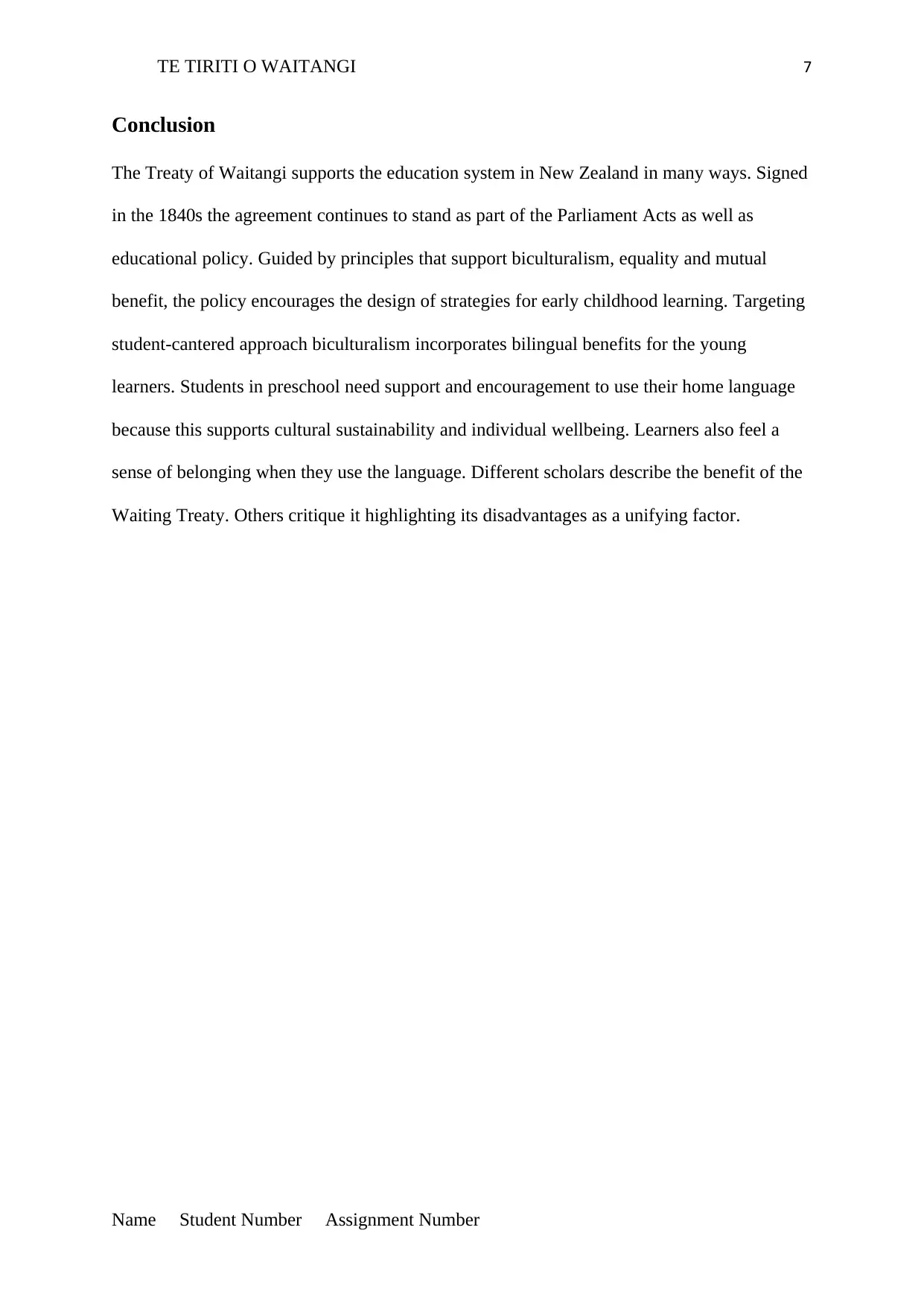
TE TIRITI O WAITANGI 7
Conclusion
The Treaty of Waitangi supports the education system in New Zealand in many ways. Signed
in the 1840s the agreement continues to stand as part of the Parliament Acts as well as
educational policy. Guided by principles that support biculturalism, equality and mutual
benefit, the policy encourages the design of strategies for early childhood learning. Targeting
student-cantered approach biculturalism incorporates bilingual benefits for the young
learners. Students in preschool need support and encouragement to use their home language
because this supports cultural sustainability and individual wellbeing. Learners also feel a
sense of belonging when they use the language. Different scholars describe the benefit of the
Waiting Treaty. Others critique it highlighting its disadvantages as a unifying factor.
Name Student Number Assignment Number
Conclusion
The Treaty of Waitangi supports the education system in New Zealand in many ways. Signed
in the 1840s the agreement continues to stand as part of the Parliament Acts as well as
educational policy. Guided by principles that support biculturalism, equality and mutual
benefit, the policy encourages the design of strategies for early childhood learning. Targeting
student-cantered approach biculturalism incorporates bilingual benefits for the young
learners. Students in preschool need support and encouragement to use their home language
because this supports cultural sustainability and individual wellbeing. Learners also feel a
sense of belonging when they use the language. Different scholars describe the benefit of the
Waiting Treaty. Others critique it highlighting its disadvantages as a unifying factor.
Name Student Number Assignment Number
Paraphrase This Document
Need a fresh take? Get an instant paraphrase of this document with our AI Paraphraser
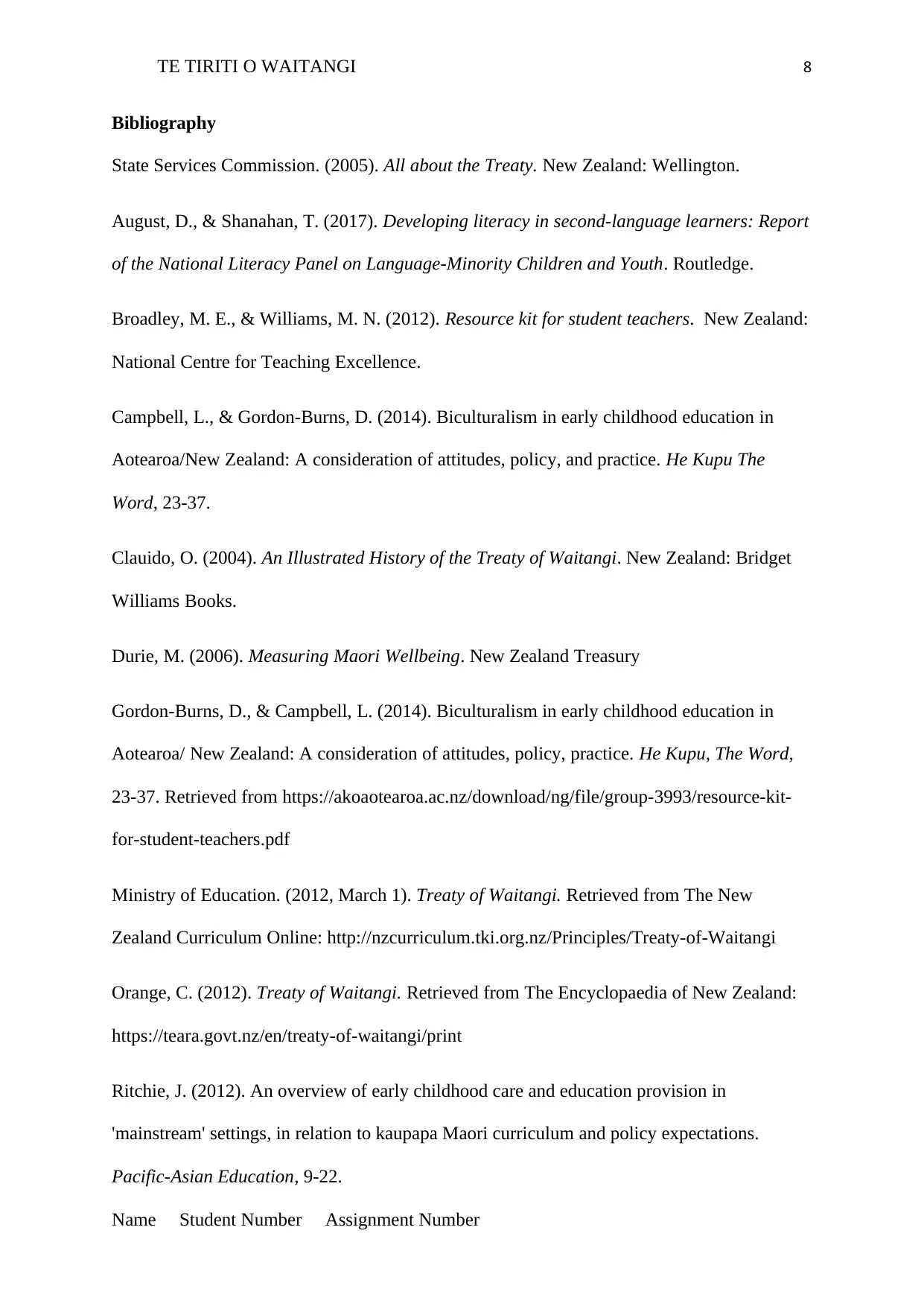
TE TIRITI O WAITANGI 8
Bibliography
State Services Commission. (2005). All about the Treaty. New Zealand: Wellington.
August, D., & Shanahan, T. (2017). Developing literacy in second-language learners: Report
of the National Literacy Panel on Language-Minority Children and Youth. Routledge.
Broadley, M. E., & Williams, M. N. (2012). Resource kit for student teachers. New Zealand:
National Centre for Teaching Excellence.
Campbell, L., & Gordon-Burns, D. (2014). Biculturalism in early childhood education in
Aotearoa/New Zealand: A consideration of attitudes, policy, and practice. He Kupu The
Word, 23-37.
Clauido, O. (2004). An Illustrated History of the Treaty of Waitangi. New Zealand: Bridget
Williams Books.
Durie, M. (2006). Measuring Maori Wellbeing. New Zealand Treasury
Gordon-Burns, D., & Campbell, L. (2014). Biculturalism in early childhood education in
Aotearoa/ New Zealand: A consideration of attitudes, policy, practice. He Kupu, The Word,
23-37. Retrieved from https://akoaotearoa.ac.nz/download/ng/file/group-3993/resource-kit-
for-student-teachers.pdf
Ministry of Education. (2012, March 1). Treaty of Waitangi. Retrieved from The New
Zealand Curriculum Online: http://nzcurriculum.tki.org.nz/Principles/Treaty-of-Waitangi
Orange, C. (2012). Treaty of Waitangi. Retrieved from The Encyclopaedia of New Zealand:
https://teara.govt.nz/en/treaty-of-waitangi/print
Ritchie, J. (2012). An overview of early childhood care and education provision in
'mainstream' settings, in relation to kaupapa Maori curriculum and policy expectations.
Pacific-Asian Education, 9-22.
Name Student Number Assignment Number
Bibliography
State Services Commission. (2005). All about the Treaty. New Zealand: Wellington.
August, D., & Shanahan, T. (2017). Developing literacy in second-language learners: Report
of the National Literacy Panel on Language-Minority Children and Youth. Routledge.
Broadley, M. E., & Williams, M. N. (2012). Resource kit for student teachers. New Zealand:
National Centre for Teaching Excellence.
Campbell, L., & Gordon-Burns, D. (2014). Biculturalism in early childhood education in
Aotearoa/New Zealand: A consideration of attitudes, policy, and practice. He Kupu The
Word, 23-37.
Clauido, O. (2004). An Illustrated History of the Treaty of Waitangi. New Zealand: Bridget
Williams Books.
Durie, M. (2006). Measuring Maori Wellbeing. New Zealand Treasury
Gordon-Burns, D., & Campbell, L. (2014). Biculturalism in early childhood education in
Aotearoa/ New Zealand: A consideration of attitudes, policy, practice. He Kupu, The Word,
23-37. Retrieved from https://akoaotearoa.ac.nz/download/ng/file/group-3993/resource-kit-
for-student-teachers.pdf
Ministry of Education. (2012, March 1). Treaty of Waitangi. Retrieved from The New
Zealand Curriculum Online: http://nzcurriculum.tki.org.nz/Principles/Treaty-of-Waitangi
Orange, C. (2012). Treaty of Waitangi. Retrieved from The Encyclopaedia of New Zealand:
https://teara.govt.nz/en/treaty-of-waitangi/print
Ritchie, J. (2012). An overview of early childhood care and education provision in
'mainstream' settings, in relation to kaupapa Maori curriculum and policy expectations.
Pacific-Asian Education, 9-22.
Name Student Number Assignment Number
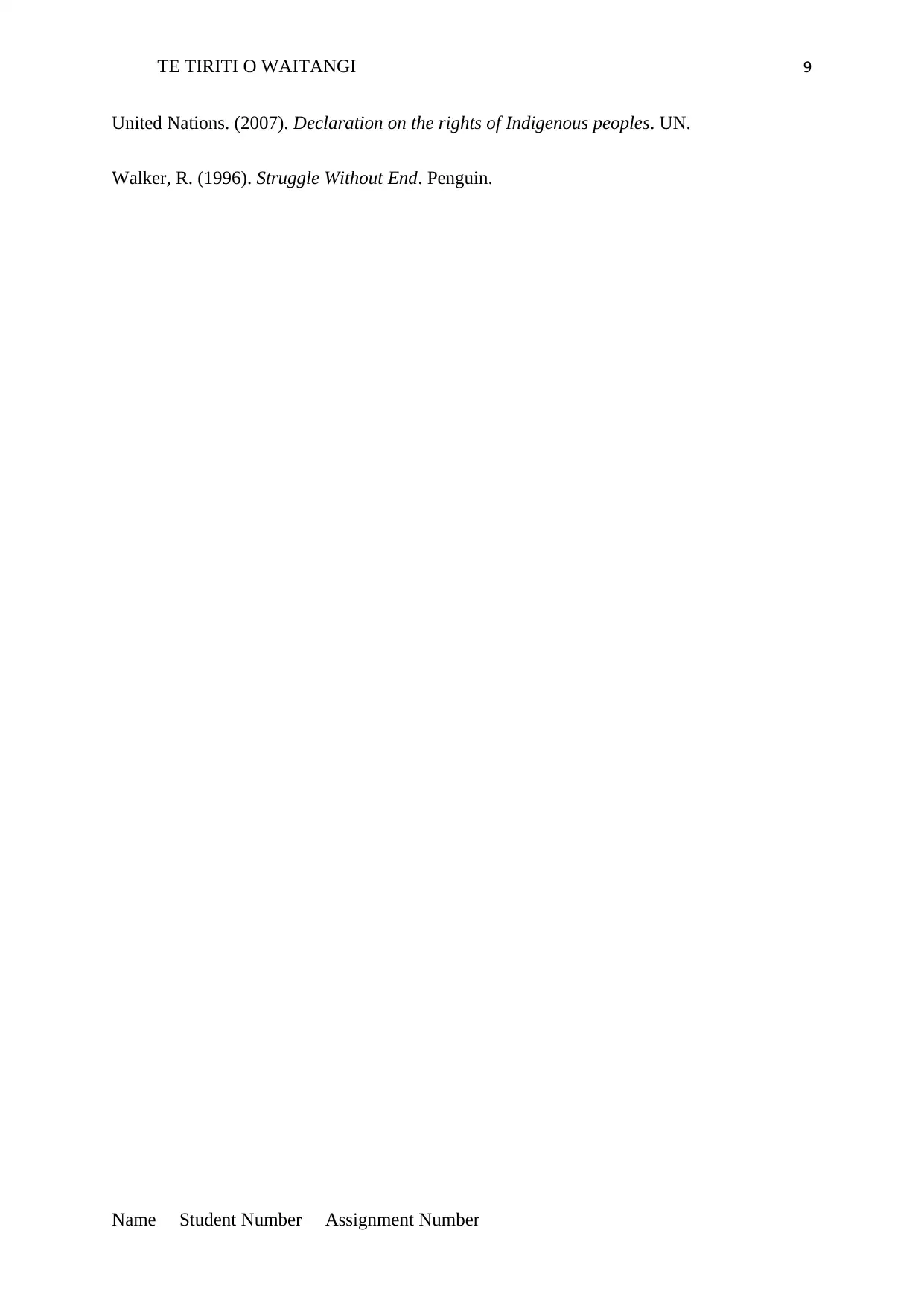
TE TIRITI O WAITANGI 9
United Nations. (2007). Declaration on the rights of Indigenous peoples. UN.
Walker, R. (1996). Struggle Without End. Penguin.
Name Student Number Assignment Number
United Nations. (2007). Declaration on the rights of Indigenous peoples. UN.
Walker, R. (1996). Struggle Without End. Penguin.
Name Student Number Assignment Number
⊘ This is a preview!⊘
Do you want full access?
Subscribe today to unlock all pages.

Trusted by 1+ million students worldwide
1 out of 9
Related Documents
Your All-in-One AI-Powered Toolkit for Academic Success.
+13062052269
info@desklib.com
Available 24*7 on WhatsApp / Email
![[object Object]](/_next/static/media/star-bottom.7253800d.svg)
Unlock your academic potential
Copyright © 2020–2025 A2Z Services. All Rights Reserved. Developed and managed by ZUCOL.





